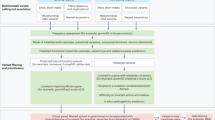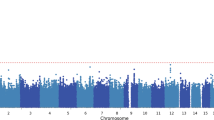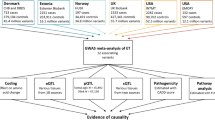Abstract
This umbrella review investigates which genetic factors are associated with drug-related movement disorders (DRMD), in an attempt to provide a synthesis of published evidence of candidate-gene studies. To identify all relevant meta-analyses, a literature search was performed. Titles and abstracts were screened by two authors and the methodological quality of included meta-analyses was assessed using ‘the assessment of multiple systematic reviews’ (AMSTAR) critical appraisal checklist. The search yielded 15 meta-analytic studies reporting on genetic variations in 10 genes. DRD3, DRD2, CYP2D6, HTR2A, COMT, HSPG2 and SOD2 genes have variants that may increase the odds of TD. However, these findings do not concur with early genome-wide association studies. Low-power samples are susceptible to ‘winner’s curse’, which was supported by diminishing meta-analytic effects of several genetic variants over time. Furthermore, analyses pertaining to the same genetic variant were difficult to compare due to differences in patient populations, methods used and the choice of studies included in meta-analyses. In conclusion, DRMD is a complex phenotype with multiple genes that impact the probability of onset. More studies with larger samples using other methods than by candidate genes, are essential to developing methods that may predict the probability of DRMD. To achieve this, multiple research groups need to collaborate and a DRMD genetic database needs to be established in order to overcome winner’s curse and publication bias, and to allow for stratification by patient characteristics. These endeavours may help the development of a test with clinical value in the prevention and treatment of DRMD.
This is a preview of subscription content, access via your institution
Access options
Subscribe to this journal
Receive 12 print issues and online access
$259.00 per year
only $21.58 per issue
Buy this article
- Purchase on Springer Link
- Instant access to full article PDF
Prices may be subject to local taxes which are calculated during checkout

Similar content being viewed by others
References
Owens DGC. A guide to the extrapyramidal side effects of anti-psychotic drugs. New York: Cambridge University Press UK; 2014.
Factor SA. Drug induced movement disorders malden, Mass: Blackwell Futura; 2005.
van Harten PN, Kahn RS. Tardive dystonia. Schizophr Bull. 1999;25:741–8.
Lambert M, Conus P, Eide P, Mass R, Karow A, Moritz S, et al. Impact of present and past antipsychotic side effects on attitude toward typical antipsychotic treatment and adherence. Eur Psychiatry. 2004;19:415–22.
Casey DE. Implications of the CATIE trial on treatment: extrapyramidal symptoms. CNS Spectr. 2006;11:25–31.
Correll CU, Schenk EM. Tardive dyskinesia and new antipsychotics. Curr Opin Psychiatry. 2008;21:151–6.
Taylor D. Antipsychotic polypharmacy—confusion reigns. Psychiatrist; 2010;34:41–43.
Mentzel TQ, Lieverse R, Bloemen O, Viechtbauer W, van Harten PN, Genetic Risk and Outcome of Psychosis (GROUP) Investigators. et al. High incidence and prevalence of drug-related movement disorders in young patients with psychotic disorders. J Clin Psychopharmacol. 2017;37:231–8.
Bakker PR, de Groot IW, van Os J, van Harten PN. Long-stay psychiatric patients: a prospective study revealing persistent antipsychotic-induced movement disorder. PLoS ONE. 2011;6:e25588.
van Harten PN, Matroos GE, Hoek HW, Kahn RS. The prevalence of tardive dystonia, tardive dyskinesia, parkinsonism and akathisia The Curacao Extrapyramidal Syndromes Study: I. Schizophr Res. 1996;19:195–203.
Glazer WM, Morgenstern H, Doucette J. Race and tardive dyskinesia among outpatients at a CMHC. Hosp Community Psychiatry. 1994;45:38–42.
Halstead SM, Barnes TR, Speller JC. Akathisia: prevalence and associated dysphoria in an in-patient population with chronic schizophrenia. Br J Psychiatry. 1994;164:177–83.
Sachse C, Brockmoller J, Bauer S, Roots I. Functional significance of a C->A polymorphism in intron 1 of the cytochrome P450 CYP1A2 gene tested with caffeine. Br J Clin Pharm. 1999;47:445–9.
Sachdev PS. Neuroleptic-induced movement disorders: an overview. Psychiatr Clin North Am. 2005;28:255–74.
Tenback DE, van Harten PN, van Os J. Non-therapeutic risk factors for onset of tardive dyskinesia in schizophrenia: a meta-analysis. Mov Disord. 2009;24:2309–15.
Leucht S, Corves C, Arbter D, Engel RR, Li C, Davis JM. Second-generation versus first-generation antipsychotic drugs for schizophrenia: a meta-analysis. Lancet. 2009;373:31–41.
Fujimaki K, Morinobu S, Yamashita H, Takahashi T, Yamawaki S. Predictors of quality of life in inpatients with schizophrenia. Psychiatry Res. 2012;197:199–205.
Schouten HJ, Knol W, Egberts TC, Schobben AF, Jansen PA, van Marum RJ. Quality of life of elderly patients with antipsychotic-induced parkinsonism: a cross-sectional study. J Am Med Dir Assoc. 2012;13:82 e81–85.
Haddad PM, Dursun SM. Neurological complications of psychiatric drugs: clinical features and management. Hum Psychopharmacol. 2008;23:15–26. Jan
Ballesteros J, Gonzalez-Pinto A, Bulbena A. Tardive dyskinesia associated with higher mortality in psychiatric patients: results of a meta-analysis of seven independent studies. J Clin Psychopharmacol. 2000;20:188–94.
Chong SA, Tay JA, Subramaniam M, Pek E, Machin D. Mortality rates among patients with schizophrenia and tardive dyskinesia. J Clin Psychopharmacol. 2009;29:5–8.
Dean CE, Thuras PD. Mortality and tardive dyskinesia: long-term study using the US National Death Index. Br J Psychiatry. 2009;194:360–4.
Suzuki M, Hurd YL, Sokoloff P, Schwartz JC, Sedvall G. D3 dopamine receptor mRNA is widely expressed in the human brain. Brain Res. 1998;779:58–74.
Accili D, Fishburn CS, Drago J, Steiner H, Lachowicz JE, Park BH, et al. A targeted mutation of the D3 dopamine receptor gene is associated with hyperactivity in mice. Proc Natl Acad Sci USA. 1996;93:1945–9.
GCCC Psychiatric, Cichon S, Craddock N, Daly M, Faraone SV, Gejman PV, et al. Genomewide association studies: history, rationale, and prospects for psychiatric disorders. Am J Psychiatry. 2009;166:540–56.
Aberg K, Adkins DE, Bukszár J, Webb BT, Caroff SN, Miller DD, et al. Genomewide association study of movement-related adverse antipsychotic effects. Biol Psychiatry. 2010;67:279–82.
Alkelai A, Greenbaum L, Rigbi A, Kanyas K, Lerer B. Genome-wide association study of antipsychotic-induced parkinsonism severity among schizophrenia patients. Psychopharmacol (Berl). 2009;206:491–9.
Greenbaum L, Alkelai A, Rigbi A, Kohn Y, Lerer B. Evidence for association of the GLI2 gene with tardive dyskinesia in patients with chronic schizophrenia. Mov Disord. 2010;25:2809–17.
Inada T, Koga M, Ishiguro H, Horiuchi Y, Syu A, Yoshio T, et al. Pathway-based association analysis of genome-wide screening data suggest that genes associated with the gamma-aminobutyric acid receptor signaling pathway are involved in neuroleptic-induced, treatment-resistant tardive dyskinesia. Pharmacogenet Genomics. 2008;18:317–23.
Tanaka S, Syu A, Ishiguro H, Inada T, Horiuchi Y, Ishikawa M, et al. DPP6 as a candidate gene for neuroleptic-induced tardive dyskinesia. Pharmacogenomics J. 2013;13:27–34.
Reynolds GP. The impact of pharmacogenetics on the development and use of antipsychotic drugs. Drug Disco Today. 2007;12:953–9.
Ohmori O, Shinkai T, Hori H, Matsumoto C, Nakamura J. A perspective on molecular genetic studies of tardive dyskinesia: one clue for individualized antipsychotic drug therapy. Prog Neuropsychopharmacol Biol Psychiatry. 2003;27:581–6.
Lerer B, Segman RH. Pharmacogenetics of antipsychotic therapy: pivotal research issues and the prospects for clinical implementation. Dialogues Clin Neurosci. 2006;8:85–94.
Lencz T, Malhotra AK. Pharmacogenetics of antipsychotic-induced side effects. Dialogues Clin Neurosci. 2009;11:405–15.
Zhang JP, Malhotra AK. Pharmacogenetics and antipsychotics: therapeutic efficacy and side effects prediction. Expert Opin Drug Metab Toxicol. 2011;7:9–37.
Lanning RK, Zai CC, Muller DJ. Pharmacogenetics of tardive dyskinesia: an updated review of the literature. Pharmacogenomics. 2016;17:1339–51.
Xiao R, Boehnke M. Quantifying and correcting for the winner’s curse in genetic association studies. Genet Epidemiol. 2009;33:453–62.
Poirier JG, Faye LL, Dimitromanolakis A, Paterson AD, Sun L, Bull SB. Resampling to address the winner’s curse in genetic association analysis of time to event. Genet Epidemiol. 2015;39:518–28.
PROSPERO. The genetics of drug-related movement disorders—an umbrella review of meta analyses; 2017. https://www.crd.york.ac.uk/PROSPERO/display_record.php?RecordID=69634.
Bakker PR, van Harten PN, van Os J. Antipsychotic-induced tardive dyskinesia and polymorphic variations in COMT, DRD2, CYP1A2 and MnSOD genes: a meta-analysis of pharmacogenetic interactions. Mol Psychiatry. 2008;13:544–56.
Fleeman N, Dundar Y, Dickson R, Jorgensen A, Pushpakom S, McLeod C, et al. Cytochrome P450 testing for prescribing antipsychotics in adults with schizophrenia: systematic review and meta-analyses. Pharmacogenomics J. 2011;11:1–14.
Patsopoulos NA, Ntzani EE, Zintzaras E, Ioannidis JP. CYP2D6 polymorphisms and the risk of tardive dyskinesia in schizophrenia: a meta-analysis. Pharmacogenet Genomics. 2005;15:151–8.
Ozdemir V, Aklillu E, Mee S, Bertilsson L, Albers LJ, Graham JE, et al. Pharmacogenetics for off-patent antipsychotics: reframing the risk for tardive dyskinesia and access to essential medicines. Expert Opin Pharmacother. 2006;7:119–33.
Lerer B, Segman RH, Tan EC. Pharmacogenetics of psychotropic drugs. 2002 ed. Cambridge: Cambridge University Press; 2002.
Bakker PR, van Harten PN, van Os J. Antipsychotic-induced tardive dyskinesia and the Ser9Gly polymorphism in the DRD3 gene: a meta analysis. Schizophr Res. 2006;83:185–92.
Neville MJ, Johnstone EC, Walton RT. Identification and characterization of ANKK1: a novel kinase gene closely linked to DRD2 on chromosome band 11q23.1. Hum Mutat. 2004;23:540–5.
Zai CC, De Luca V, Hwang RW, Voineskos A, Muller DJ, Remington G, et al. Meta-analysis of two dopamine D2 receptor gene polymorphisms with tardive dyskinesia in schizophrenia patients. Mol Psychiatry. 2007;12:794–5.
Cadet JL, Lohr JB. Possible involvement of free radicals in neuroleptic-induced movement disorders. Evidence from treatment of tardive dyskinesia with vitamin E. Ann N Y Acad Sci. 1989;570:176–85.
Patsopoulos NA, Ntzani EE, Zintzaras E, Ioannidis JP. CYP2D6 polymorphisms and the risk of tardive dyskinesia in schizophrenia: a meta-analysis. Pharmacogenet Genomics. 2005;15:151–158. https://doi.org/10.1097/01213011-200503000-00003.
Park H, Poo MM. Neurotrophin regulation of neural circuit development and function. Nat Rev Neurosci. 2013;14:7–23.
Egan MF, Kojima M, Callicott JH, Goldberg TE, Kolachana BS, Bertolino A, et al. The BDNF val66met polymorphism affects activity-dependent secretion of BDNF and human memory and hippocampal function. Cell. 2003;112:257–69.
Nicole S, Davoine CS, Topaloglu H, Cattolico L, Barral D, Beighton P, et al. Perlecan, the major proteoglycan of basement membranes, is altered in patients with Schwartz-Jampel syndrome (chondrodystrophic myotonia). Nat Genet. 2000;26:480–3.
Syu A, Ishiguro H, Inada T, Horiuchi Y, Tanaka S, Ishikawa M, et al. Association of the HSPG2 gene with neuroleptic-induced tardive dyskinesia. Neuropsychopharmacology. 2010;35:1155–64.
Shea BJ, Grimshaw JM, Wells GA, Boers M, Andersson N, Hamel C, et al. Development of AMSTAR: a measurement tool to assess the methodological quality of systematic reviews. BMC Med Res Methodol. 2007;7:10.
Namipashaki A, Razaghi-Moghadam Z, Ansari-Pour N. The essentiality of reporting hardy-weinberg equilibrium calculations in population-based genetic association studies. Cell J Summer. 2015;17:187–92.
Lerer B, Segman RH, Fangerau H, Daly AK, Basile VS, Cavallaro R, et al. Pharmacogenetics of tardive dyskinesia: combined analysis of 780 patients supports association with dopamine D3 receptor gene Ser9Gly polymorphism. Neuropsychopharmacology. 2002;27:105–19.
Utsunomiya K, Shinkai T, Sakata S, Yamada K, Chen HI, De Luca V, et al. Genetic association between the dopamine D3 receptor gene polymorphism (Ser9Gly) and tardive dyskinesia in patients with schizophrenia: a reevaluation in East Asian populations. Neurosci Lett. 2012;507:52–56.
Tsai HT, North KE, West SL, Poole C. The DRD3 rs6280 polymorphism and prevalence of tardive dyskinesia: a meta-analysis. Am J Med Genet B Neuropsychiatr Genet. 2010;153B:57–66.
Zai CC, Tiwari AK, Müller DJ, De Luca V, Shinkai T, Shaikh S, et al. The catechol-O-methyl-transferase gene in tardive dyskinesia. World J Biol Psychiatry. 2010;11:803–12.
Lv Z, Rong B, Tong X, Li X, Chen X, Wang X, et al. The association between COMT Val158Met gene polymorphism and antipsychotic-induced tardive dyskinesia risk. Int J Neurosci. 2016;126:1044–50.
Lerer B, Segman RH, Tan EC, Basile VS, Cavallaro R, Aschauer HN, et al. Combined analysis of 635 patients confirms an age-related association of the serotonin 2A receptor gene with tardive dyskinesia and specificity for the non-orofacial subtype. Int J Neuropsychopharmacol. 2005;8:411–25.
Galecki P, Pietras T, Szemraj J. Manganese superoxide dismutase gene (MnSOD) polimorphism in schizophrenics with tardive dyskinesia from central Poland. Psychiatr Pol. 2006;40:937–48.
Pae CU, Yoon SJ, Patkar A, Kim JJ, Jun TY, Lee C, et al. Manganese superoxide dismutase (MnSOD: Ala-9Val) gene polymorphism and mood disorders: a preliminary study. Prog Neuropsychopharmacol Biol Psychiatry. 2006;30:1326–9.
Zai CC, Tiwari AK, Basile V, de Luca V, Müller DJ, Voineskos AN, et al. Oxidative stress in tardive dyskinesia: genetic association study and meta-analysis of NADPH quinine oxidoreductase 1 (NQO1) and Superoxide dismutase 2 (SOD2, MnSOD) genes. Prog Neuropsychopharmacol Biol Psychiatry. 2010;34:50–56.
Wang DF, Cao B, Xu MY, Liu YQ, Yan LL, Liu R, et al. Meta-analyses of manganese superoxide dismutase activity, gene Ala-9Val polymorphism, and the risk of schizophrenia. Med (Baltim). 2015;94:e1507.
Miura I, Zhang JP, Nitta M, Lencz T, Kane JM, Malhotra AK, et al. BDNF Val66Met polymorphism and antipsychotic-induced tardive dyskinesia occurrence and severity: a meta-analysis. Schizophr Res. 2014;152:365–72.
Zai CC, Lee FH, Tiwari AK, Lu JY, de Luca V, Maes MS, et al. Investigation of the HSPG2 gene in tardive dyskinesia—new data and meta-analysis. Front Pharm. 2018;9:974.
Hellwege JN, Keaton JM, Giri A, Gao X, Velez Edwards DR, Edwards TL. Population stratification in genetic association studies. Curr Protoc Hum Genet. 2017;95:1–22.
Segman RH, Heresco-Levy U, Finkel B, Goltser T, Shalem R, Schlafman M, et al. Association between the serotonin 2A receptor gene and tardive dyskinesia in chronic schizophrenia. Mol Psychiatry. 2001;6:225–9.
Basile VS, Masellis M, Potkin SG, Kennedy JL. Pharmacogenomics in schizophrenia: the quest for individualized therapy. Hum Mol Genet. 2002;11:2517–30.
Farrell MS, Werge T, Sklar P, Owen MJ, Ophoff RA, O’Donovan MC, et al. Evaluating historical candidate genes for schizophrenia. Mol Psychiatry. 2015;20:555–62.
Wells G, Shea B, O’Connell D, Peterson J, Welch V, Losos M, et al. The Newcastle-Ottawa Scale (NOS) for assessing the quality of nonrandomised studies in meta-analyses. 2013. Available at: http://www.ohri.ca/programs/clinical_epidemiology/oxford.asp.
Abdolmaleky HM, Thiagalingam S, Wilcox M. Genetics and epigenetics in major psychiatric disorders: dilemmas, achievements, applications, and future scope. Am J Pharmacogenomics. 2005;5:149–60.
Chin L, Andersen JN, Futreal PA. Cancer genomics: from discovery science to personalized medicine. Nat Med. 2011;17:297–303.
Tannock IF, Hickman JA. Limits to personalized cancer medicine. N. Engl J Med. 2016;375:1289–94.
Author information
Authors and Affiliations
Corresponding author
Ethics declarations
Conflict of interest
The authors declare that they have no conflict of interest.
Additional information
Publisher’s note Springer Nature remains neutral with regard to jurisdictional claims in published maps and institutional affiliations.
Rights and permissions
About this article
Cite this article
van der Burg, N.C., Al Hadithy, A.F.Y., van Harten, P.N. et al. The genetics of drug-related movement disorders, an umbrella review of meta-analyses. Mol Psychiatry 25, 2237–2250 (2020). https://doi.org/10.1038/s41380-020-0660-5
Received:
Revised:
Accepted:
Published:
Issue Date:
DOI: https://doi.org/10.1038/s41380-020-0660-5
This article is cited by
-
Genetics of autism spectrum disorder: an umbrella review of systematic reviews and meta-analyses
Translational Psychiatry (2022)
-
Antipsychotic-induced catatonia and neuroleptic malignant syndrome: the dark side of the moon
Molecular Psychiatry (2021)
-
Die sensomotorische Domäne im Research-Domain-Criteria-System: Fortschritte und Perspektiven
Der Nervenarzt (2021)



